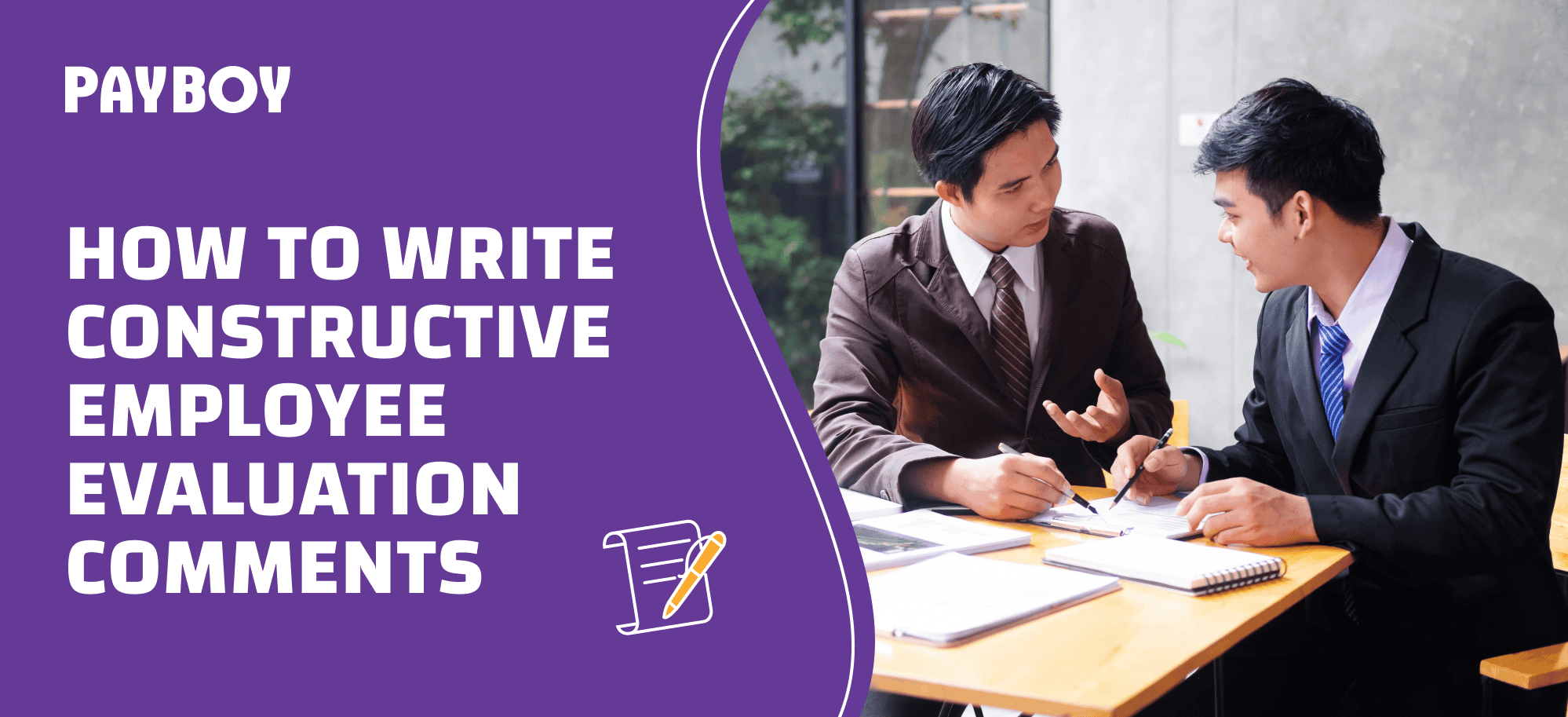Employee evaluations are vital for driving productivity, engagement, and development within any organisation. Yet, employers often face challenges in crafting comments that are both constructive and motivating. When handled well, evaluation comments can guide employees, foster growth, and align individual goals with the company’s mission. However, poorly structured evaluation can lead to misunderstandings, low morale, and disengagement. In this guide, we’ll explore best practices for writing impactful employee evaluation comments.
Employee evaluation comments serve as a key form of communication between employers and employees. Specific, clear feedback helps employees understand how their work is perceived, what they are doing well, and where there is room for improvement. This guidance enables employees to set goals and grow within their roles, ultimately contributing to the organisation’s success.
Types of employee evaluation comments:
Evaluation comments typically fall into two categories:
- Constructive feedback: This type helps employees understand areas needing improvement without being overly critical.
- Positive reinforcement: Positive comments reinforce desirable behaviours and achievements, motivating employees to continue excelling.
What’s the impact of employee evaluation comments on engagement and retention?
Building a strong feedback culture can significantly enhance employee engagement and retention, as studies reveal the profound impact of regular, meaningful feedback. Gallup data show that 80% of employees who receive constructive feedback at least weekly report being fully engaged, indicating that consistent evaluations can boost morale and collaboration. PwC further supports this, finding that organisations using real-time feedback systems experience a 15% increase in employee satisfaction. These insights demonstrate that well-structured evaluations not only strengthen workplace relationships but also drive measurable business outcomes, encouraging organisations to make continuous improvement a core part of their culture.
- Focus on key aspects of performance:
Instead of generalising, focus comments on core competencies relevant to each employee’s role, such as teamwork, leadership, or problem-solving. Evaluating these areas individually makes it easier for employees to understand exactly where they stand and what they need to focus on.
- The STAR method:
The STAR method (Situation, Task, Action, Result) is a highly effective structure for evaluation comments. This approach:
- Provides context to the feedback.
- Clearly states the employee’s task or responsibility.
- Outline the action they took.
- Describes the outcome or result.
- Positive framing of common pitfalls:
Employers should avoid vague language (e.g., “Good job”), personal biases, and overly critical phrasing that could demotivate. For example, rather than saying, “You don’t meet deadlines,” use, “Let’s explore ways to enhance time management skills to ensure deadlines are consistently met." Instead of saying, “You lack attention to detail,” frame it as “Increasing attention to detail could further strengthen your work’s quality.”
- Actionable suggestions:
Effective evaluation is not just about identifying areas of improvement but also about providing actionable suggestions. For instance, “Consider using project management tools to help keep track of timelines” is more useful than simply stating that the employee needs better organisation skills.
- Follow-up plans:
After providing constructive feedback to an employee on improving time management, a manager could set up a follow-up plan that includes specific steps and regular check-ins. For instance, they might encourage the employee to use a task management tool and set weekly goals to prioritise tasks more effectively. Additionally, the manager could schedule brief check-in meetings every two weeks to review progress, offer guidance, and adjust strategies if needed. This approach not only helps the employee stay accountable but also reinforces the support needed to achieve sustainable improvement.
Recognising achievements:
Acknowledging achievements motivates employees to continue performing at their best. Employers should use specific, genuine comments that clearly articulate the positive impact of the employee’s work.
- Examples of Positive Comments:
- “Your attention to detail significantly improved the project outcomes and streamlined the process for the entire team.”
- “Your leadership in the last quarter contributed to a 20% productivity increase, which has greatly benefited the department.”
Balancing praise and constructive input:
Even when providing positive feedback, including a potential area for growth can be beneficial. For instance, “You’ve done exceptionally well in managing client relations; developing stronger cross-functional communication could make your role even more impactful.”
Recognising efforts and small wins:
For employees whose performance may be lower, it’s still essential to acknowledge their efforts and any positive contributions they’ve made. Genuine comments can reinforce positive behaviour and encourage improvement.
- Examples of Positive Comments:
- “I appreciate your effort in tackling the recent project challenges. Your dedication to finding solutions has shown a strong commitment to the team’s goals.”
- “Your attention to maintaining client satisfaction has helped sustain positive client relationships, which is a valuable contribution to our team.”
Balancing encouragement with areas for growth:
When addressing lower performance, combine positive feedback with constructive suggestions to inspire improvement. For example:
- “Your persistence in learning new skills is commendable; focusing on time management strategies could further enhance your productivity and efficiency.”
- “I appreciate your collaborative spirit; working on consistency in meeting deadlines could strengthen your overall performance.”
The importance of tailoring comments based on employee roles and levels
Tailoring feedback based on an employee’s role and experience level is essential to ensuring relevance and impact. It will also help employees at every level understand their unique contributions and provide actionable insights that align with their role’s expectations.
- For entry-level employees, comments may focus on developing foundational skills and understanding workflows, using encouragement to build confidence as they grow. For example, acknowledging their attention to detail or their initiative in learning new processes can encourage them to deepen their skill set.
- In contrast, feedback for mid-level employees might address strategic thinking or cross-functional collaboration, as they’re typically expected to contribute more independently and take on larger responsibilities. Positive comments could highlight their problem-solving abilities or leadership in managing projects, motivating them to refine these skills further.
- For senior roles, feedback should align with high-level outcomes and leadership expectations. Recognising achievements in mentoring others, driving team success, or advancing organisational goals can affirm their value while inspiring them to continue setting a strong example.
Different roles, different comments:
Evaluation comments should reflect the specific responsibilities and performance metrics of each role. Feedback for a sales role, for example, may focus on client acquisition and revenue targets, whereas for an IT role, comments might concentrate on problem solving and technical accuracy.
To streamline the evaluation process, here are sample phrases categorised by common competencies:
Leadership:
- “Your leadership in coordinating the project was instrumental in achieving our objectives ahead of schedule.”
- “You’ve shown strong decision-making skills, especially in high-pressure situations, which has positively influenced team performance.”
- “Your proactive approach to mentorship has supported team members in achieving their personal development goals.”
Communication:
- “You consistently communicate updates and ideas clearly, ensuring all stakeholders are well-informed and engaged.”
- “Your open and approachable communication style encourages others to share ideas and feedback, enhancing team dynamics.”
- “Your ability to listen and respond thoughtfully to team concerns has improved team cohesion and trust.”
Innovation:
- “Your out-of-the-box thinking has led to innovative solutions that significantly improved our workflow.”
- “You demonstrated creativity in tackling challenges, and your ideas have had a noticeable positive impact on our project outcomes.”
- “Your initiative in suggesting new strategies has opened opportunities for us to streamline processes and reduce costs.”
Team Collaboration:
- “Your positive attitude and willingness to assist colleagues create an environment of teamwork and mutual respect.”
- “Your collaborative approach has been key in resolving conflicts and promoting a cooperative team atmosphere.”
- “You consistently encourage others to share their perspectives, fostering inclusivity and teamwork.”
Dependability:
- “Your reliability in meeting deadlines and producing high-quality work builds trust within the team.”
- “You consistently complete tasks with minimal supervision, showing a strong commitment to our goals.”
- “Your dependable performance on critical projects has been a cornerstone of our team’s success.”
Problem-Solving:
- “Your quick thinking in handling unexpected issues has prevented project delays and kept the team on track.”
- “You demonstrate excellent analytical skills, consistently identifying root causes and proposing effective solutions.”
- “Your proactive approach to tackling challenges reflects your strong problem-solving skills and resilience.”
Adaptability:
- “You adapt quickly to changes and remain positive under pressure, which helps the team navigate challenges smoothly.”
- “Your flexibility in taking on new responsibilities and shifting priorities shows great resilience and versatility.”
- “Your ability to adapt to new technology and processes sets an example for the team and enhances productivity.”
Attention to Detail:
- “Your keen eye for detail ensures our work is of the highest quality, preventing potential errors before they occur.”
- “You are meticulous in reviewing tasks, which has significantly improved the accuracy and reliability of our deliverables.”
- “Your careful attention to details in planning has helped us avoid unnecessary risks and improved project outcomes.”
Customer Focus:
- “Your dedication to understanding and meeting client needs has strengthened our customer relationships.”
- “You consistently go above and beyond to ensure our customers feel valued and supported.”
- “Your focus on customer satisfaction has earned us positive feedback and repeat business.”
Tailoring these common phrases based on individual performance and contributions can create effective, specific feedback that resonates with employees.
Does technology enhance the process of employee evaluations?
Yes, technology significantly enhances the process of employee evaluations in several ways. Here are some key arguments supporting this:
- Automating and standardising evaluations:
Technology automates many aspects of the evaluation process, saving time and reducing administrative burden. For example, Payboy’s appraisal system streamlines feedback collection, tracking, and management. This streamlined process allows HR teams to focus on higher-level tasks, such as strategising talent development plans, rather than spending excessive time on manual data reporting. Moreover, it also supports fair, standardised evaluations and minimises administrative time.
- Real-time evaluations:
With the use of digital tools, employee evaluation can be delivered in real time, which is essential for improving employee performance. Rather than waiting for an annual review, employees can receive immediate, actionable feedback that allows them to make adjustments quickly. This continuous feedback loop encourages growth and keeps employees engaged.
- Data-driven evaluation:
Technology enables companies to gather and analyse large amounts of performance data across various metrics, such as productivity, goal achievement, and even employee sentiment. This data-driven approach provides objective insights into employee performance, which helps remove bias from evaluations.
- Encouraging continuous feedback:
With features for ongoing feedback, Payboy’s appraisal system allows managers and employees to engage in a continuous feedback loop. This encourages a culture of regular, constructive dialogue that boosts engagement and aligns everyone with organisational goals.
- Remote and flexible evaluations:
As more organisations embrace hybrid and remote working models, technology allows performance evaluations to take place seamlessly, regardless of location. Employees can provide feedback, set goals, and track progress through online platforms, making evaluations accessible to all employees, whether in the office or working remotely. This flexibility ensures that no employee is overlooked, regardless of their work environment.
Using HR software to manage performance appraisals can help organisations effectively and efficiently manage employee evaluations, feedback, and reviews. This allows managers to spend less time on administrative tasks and more time focusing on important strategic initiatives.
If you're looking for an affordable solution that's easy to use, customisable to your unique needs, and accessible from any device, consider Payboy HR & Payroll software!
With Payboy's appraisal system module, you can:
- Customise unique performance appraisal forms for each employee, based on their function and role.
- Set up 360-degree feedback to gather fair and all-round assessment for each employee.
- Store all historical appraisals in the cloud to gain valuable insights into employee productivity and performance over time.
Streamline your HR processes with Payboy today!
As a PSG-approved HRMS, Payboy provides a robust system to help you manage your HR tasks so that you can focus on your business and people!
With our wide range of modules, you can customise a solution to meet the specific needs of your business:
Payroll Processing | Leave Management | Claims Management | Applicant Tracking
Time Attendance | Shift Scheduling | Appraisal System | Inventory Management
Project Costing | Training Management | Benefits





















